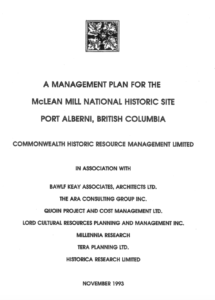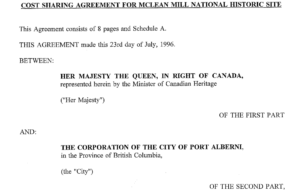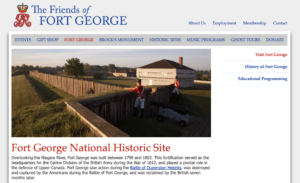Sent Tuesday, August 6, 2019. Published August 14.
Dear Editor,
In November 1993, the first plan (pdf) was put together to guide the development of the McLean Mill National Historic Site. The agreement between the City and Federal government (pdf) that set the City to run it for 42 years and have Government provide one-time capital funding of $2.6 Million was signed in 1996. Now the McLean Mill Society is going to deliver yet another plan.
National Historic Sites are a service that small cities cannot afford, should not have to, and usually don’t. Why? Because National Historic Sites are for all Canadians. Perhaps that is at the root of why the past 26 years have been so difficult.
In the Niagara region of Ontario, Fort George National Historic Site attracts millions of visitors a year, is a huge contributor to the local economy, and is run and maintained by Parks Canada.
A Society called “Friends of Fort George†holds fundraisers, gets grants, hires students, and runs a gift shop but all of the infrastructure and permanent staffing is Parks Canada’s responsibility.
It’s time McLean Mill was the same.
If 26 years has taught us anything it should be that despite all the best intentions and tireless work of volunteers, city leaders, and local business people, and many more millions in local tax dollars than government gave us, preserving old buildings and infrastructure properly using old technology in a new regulatory environment is far too much for a City of 17,000 to manage.
Stop beating around the bush with new plans that are essentially the same as the old plans.
It’s time the Mayor and Council call Ottawa and start negotiating a new agreement for McLean Mill National Historic Site that puts the responsibility in the right place for all of Canada to enjoy forever.
P.S. (not included with letter to the Paper)
I’ve enjoyed many visits to the Mill site over the years both by train and otherwise. I believe many of the things that the McLean Mill Society began to put in place were what was needed to get the most out of this incredible asset.
Unfortunately, the cost of the infrastructure itself, the professional staffing required, and the regulatory risk is simply too much for a City like Port Alberni to take on.
I think that 1996 agreement was essentially an exercise in senior government downloading responsibility onto local governments and it has predictably failed.
Add to that the inclusion of the steam train and Alberni Pacific Railway which, as far as I know is unique to any other National Historic Site in Canada and it is truly a step above. But it is all just too much.
In 1996, the railway was still being maintained by Rail America and CPR and the volunteers at the mill were ready to take anything on in terms of buildings and maintenance at the site.
Things have changed drastically in the intervening two decades. The railway is no longer maintained by its owner and the costs to maintain the Site have skyrocketed along with the liability from historic contamination and new building and work practices.
I believe handing the Site over to Parks Canada gives the best chance of returning the whole experience to its glory in the early 2000s and achieving the true potential that the City of Port Alberni, Western Vancouver Island Industrial Heritage Society and McLean Mill Society, countless volunteers, community members and visitors had just scratched the surface of.
Here’s hoping.




